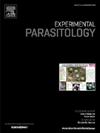Efficacy of nitrofurantoin in treatment of murine model of trichinellosis
IF 1.6
4区 医学
Q3 PARASITOLOGY
引用次数: 0
Abstract
Treatment of trichinellosis is still challenging. Lack of an established effective and safe treatment for trichinellosis, directed attention towards repurposing the already available drugs. Thus, the aim of this study was to evaluate the effectiveness of nitrofurantoin (NF) as compared to albendazole (ABZ) and their combination in treatment of trichinellosis in mice. Mice were divided into five groups; Group I: negative control; Group II: positive control; Groups III, IV and V: infected and treated with ABZ, NF, and combined ALB with NF respectively. They were subdivided into subgroups (a) started treatment on 3rd day postinfection (PI) and were sacrificed on 6th day PI, and subgroups (b) started treatment on 21st day PI and were sacrificed on 35th day PI. Parasitological, histopathological, immunohistochemical, immunological and biochemical studies were done. The results showed that NF was potential effective in treatment of trichinellosis and its combination with ABZ achieved the best results as compared to ABZ alone. This combination significantly reduced adults (66.5 %) and larvae (87.1 %) counts in the intestinal and muscular phases respectively. Also, it significantly decreased the inflammation and serum interferon gamma (IFN-γ) levels with mean of 11.6 ± 0.43 and 15.8 ± 0.74 in the early and late stages of trichinellosis respectively. Additionally, it had antiangiogenic effects evidenced by decreasing the microvessel density/HPF with a reduction rate of 91.65 %, antioxidant effects by decreasing malondialdehyde (MDA) with mean ± SD of 0.73 ± 0.09 and increasing superoxide dismutase (SOD) with mean ± SD of 156.6 ± 5.2 in addition to its apoptotic effects by decreasing B-cell lymphoma (BCL-2) levels with mean ± SD of 0.81 ± 0.08 in the infected muscle cells. Thus, It was concluded that NF could be a promising anti-trichinellosis drug and its combination with ABZ could be an efficient treatment for early and late experimental trichinellosis.

呋喃妥因对小鼠旋毛虫病模型的治疗作用。
旋毛虫病的治疗仍然具有挑战性。由于缺乏针对旋毛虫病的既定有效和安全的治疗方法,人们将注意力转向重新利用现有药物。因此,本研究的目的是评价呋喃妥英(NF)与阿苯达唑(ABZ)及其联合治疗小鼠旋毛虫病的有效性。将小鼠分为五组;第一组:阴性对照;第二组:阳性对照;III、IV、V组:分别用ABZ、NF和ALB联合NF感染和治疗。再分为感染后第3天开始治疗,第6天处死的亚组(a)和感染后第21天开始治疗,第35天处死的亚组(b)。进行了寄生虫学、组织病理学、免疫组织化学、免疫学和生化研究。结果表明,NF对旋毛虫病具有潜在的治疗效果,与ABZ合用效果优于单用ABZ。该组合可显著降低肠道期成虫数量(66.5%)和肌肉期幼虫数量(87.1%)。血清干扰素γ (IFN-γ)水平在旋毛虫病早期和晚期的平均值分别为11.6±0.43和15.8±0.74。此外,它还具有抗血管生成作用,降低微血管密度/HPF,降低率为91.65%;抗氧化作用,降低丙二醛(MDA),平均±SD为0.73±0.09;提高超氧化物歧化酶(SOD),平均±SD为156.6±5.2;凋亡作用,降低b细胞淋巴瘤(BCL-2)水平,平均±SD为0.81±0.08。因此,NF可能是一种有前景的抗旋毛虫病药物,与ABZ联合治疗早期和晚期实验性旋毛虫病可能是一种有效的治疗方法。
本文章由计算机程序翻译,如有差异,请以英文原文为准。
求助全文
约1分钟内获得全文
求助全文
来源期刊

Experimental parasitology
医学-寄生虫学
CiteScore
3.10
自引率
4.80%
发文量
160
审稿时长
3 months
期刊介绍:
Experimental Parasitology emphasizes modern approaches to parasitology, including molecular biology and immunology. The journal features original research papers on the physiological, metabolic, immunologic, biochemical, nutritional, and chemotherapeutic aspects of parasites and host-parasite relationships.
 求助内容:
求助内容: 应助结果提醒方式:
应助结果提醒方式:


